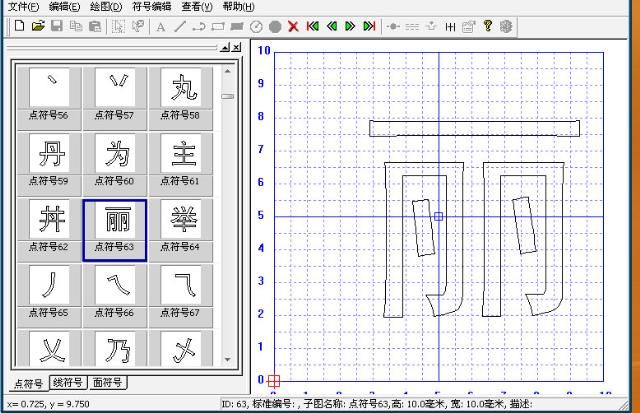TrueTypeFont文件中汉字的矢量化与绘制
http://www.cnblogs.com/wuhanhoutao/archive/2008/01/10/1033782.html
在 C:"WINDOWS"Fonts 文件夹下面有几个矢量字体文件,如SIMFANG.TTF,SIMHEI.TTF,SIMKAI,SIMSUN分别对应着仿宋体,黑体,楷体和宋体。希望首先提取文件当中的存储的汉字位置信息,接着完成矢量化处理后,然后采用DC或OpenGL进行绘制。从表面上看,这个工作也就是想实现Windows API中间的TextOut和wglUseFontOuline等函数所实现的功能。但自己编程实现汉字的矢量化,能在后续工作中获得更多的灵活性,比如将用户输入的汉字换行处理,根据用户的输入对汉字进行任意角度的倾斜,总之,主动性掌握在自己手里。完成矢量化工作后,对这些汉字的处理如同处理普通的矢量图形一样,相当方便,而再不仅仅受制于系统 API所能提供的功能。具体的步骤为:
1) 根据Unicode编码标准,存储汉字的编码表 。
wchar_t Mystring[1001]; //存储准备显示的宽字符的编码
count = 0;
for (i=0;i<1000;i++)
{
Mystring[count] = 19968 + i; //十进制的对应着十六进制的e00
count++;
}
Mystring[1000] = '"0';
上面的例子中只准备提取1000个汉字,其实可以让循环从4e00进行到9521(十六进制),代表十进制的19968和38176,分别对应着汉字:一,锠。
2)采用FreeType2代码读取*.ttf文件,得到每个汉字的轮廓信息。
while( *c) //依次处理字符
{
fonts[0]->CheckGlyph(*c);
++c;
}
3)在上叙第2步当中,完成矢量化工作的过程中,可采用De Casteljau算法处理贝塞尔(bezier)曲线。
矢量化工作的入口:
for( short contourIndex = 0; contourIndex < ftContourCount; ++contourIndex)
{
FT_Vector* pointList = &outline.points[startIndex];
char* tagList = &outline.tags[startIndex];
endIndex = outline.contours[contourIndex];
contourLength = ( endIndex - startIndex) + 1;
FTContour* contour = new FTContour( pointList, tagList, contourLength);
contourList[contourIndex] = contour;
startIndex = endIndex + 1;
}
4)根据提取的位置信息,采用DC或OpenGL进行绘制。
//采用DC绘制
for( unsigned int c = 0; c < numContours; ++c)
{
const FTContour* contour = vectoriser.Contour(c);
iPolylineNumbers = iPolylineNumbers + 1;
geoAtomLine =(geoatom::CGeoAtomPolyline**)realloc(geoAtomLine,iPolylineNumbers*sizeof(geoatom::CGeoAtomPolyline*));
geoAtomLine[iPolylineNumbers-1] = new geoatom::CGeoAtomPolyline(); //原子分配内存,由于数组从开始记数,标记总是比个数少
for( unsigned int pointIndex = 0; pointIndex < contour->PointCount(); ++pointIndex)
{
FTPoint point = contour->Point(pointIndex);
geoAtomLine[iPolylineNumbers-1]->GetPtList()->add(fXaddition+iSize*point.X()/64.0f,fYaddition+iSize*point.Y()/64.0f);
}
geoAtomLine[iPolylineNumbers-1]->SetClosed(true); //将线段形成的区域封闭起来
geoSymPoint[iPointSymbolNum-1]->AddAtom(geoAtomLine[iPolylineNumbers-1]); //将线要素添加到这个符号中
}
}
//采用OpenGL进行绘制。
for( unsigned int c = 0; c < numContours; ++c)
{
const FTContour* contour = vectoriser.Contour(c);
glBegin( GL_LINE_LOOP); //首尾相连接的多边形
for( unsigned int pointIndex = 0; pointIndex < contour->PointCount(); ++pointIndex)
{
FTPoint point = contour->Point(pointIndex);
// glVertex2f( point.X() / 64.0f, point.Y() / 64.0f); //提取顶点信息,绘制的落脚点
}
// glEnd();
